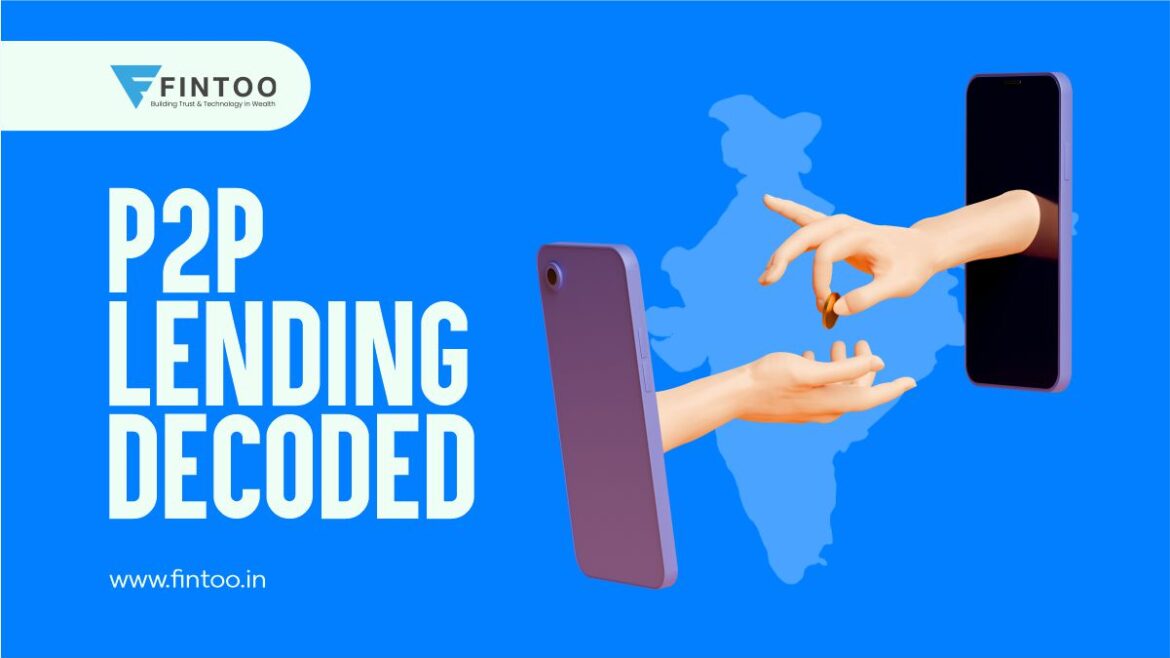

How do banks make money? Simple, when you deposit your money with a bank, they further lend it to borrowers at a higher interest rate compared to the rate you get as the interest on your deposits. And that margin between the interest earned by lending and the interest paid on deposits is the profit for banks.
For example, you deposit a certain amount of money with a bank at a 5% rate of interest, and banks lend that money to their borrowers at 12%. Hence, banks make 7% profit. Now imagine if you could lend this money directly to the people seeking to borrow funds, and earn that 12% rate of return straight without any mediator. Interesting right? This is where Peer-To-Peer lending comes into the picture.
What is P2P Lending?
Peer-To-Peer (P2P) lending is a type of financial transaction in which individuals lend and borrow money directly to each other without using a traditional financial institution as an intermediary. This platform facilitates these transactions by connecting borrowers and lenders and handling the process of loan origination, underwriting, and servicing.
P2P lending can offer a number of benefits to both borrowers and lenders. For borrowers, P2P lending may offer access to funding that may not be available through traditional lending channels, such as banks. P2P loans may also have lower interest rates than other types of loans, such as credit card loans. For lenders, P2P lending can provide an opportunity to earn a higher return on their investments compared to traditional investments, such as certificates of deposit or savings accounts.
P2P Lending in India
P2P lending in India is set to grow into a $5 billion industry by 2023. Peer-To-Peer (P2P) lending is a relatively new concept in India, but in recent years it has gained popularity as an alternative source of financing for both borrowers and investors.
In India, P2P lending platforms are regulated by the Reserve Bank of India (RBI), which has issued guidelines for the operation of these platforms. According to the RBI, P2P lending platforms in India must register with the central bank and comply with certain requirements, including maintaining a minimum net-owned fund of INR 2 crore (approximately $270,000), having a board of directors with at least 50% independent directors, and submitting regular reports to the RBI.
How does P2P lending work?
P2P lending platforms in India offer a range of loan products, including personal loans, business loans, and loans for education and home improvement. On these platforms, borrowers can typically apply for loans online and receive funding within a few days, subject to the platform’s underwriting standards and the borrower’s creditworthiness.
Lenders on P2P lending platforms in India can invest in a variety of loan products and earn returns through the interest and principal payments made by borrowers. It is crucial for lenders to carefully consider the risks of P2P lending. This includes the risk of default by borrowers and the potential of losses due to the platform’s operations.
How much return can you make from P2P Lending?
The return in P2P lending depends on how much risk you are willing to take. The risk can be measured on the basis of two parameters: one, the borrower’s creditworthiness, and second, the tenure for which you lend.
The longer the lending period, the higher the returns. And, the poor the credit track record of a borrower, the higher the returns. The data from popular P2P lending platforms shows that their users can typically make 12% – 18%.
You need to consider two things while looking at the returns from P2P lending, the default rate, and the platform fees. That’s because your actual returns will get reduced due to these factors. For example, if you earn an 18% return from your investment and the non-performing assets account for 5%, your net returns will come to 13%. Let’s say there is a 2.5% platform fee. In that case, your net return will come to 10.5%.
Taxation rules on returns from P2P Lending
Talking about the returns generated from P2P lending, investors earn interest from the amount they lend to borrowers, and just like interest earned from other instruments like fixed deposits, interest income from P2P lending is taxable and taxed as per the tax slab the lender falls in. So, if someone is in the 30% tax bracket, he will pay 30% tax on the interest earned.
For example, if you invest Rs. 1 lakh in P2P lending, and the interest earned from the principal amount is 15% or Rs. 15,000, assuming that you fall in the 30% slab, you will pay Rs. 4,500 (30% of Rs. 15,000) in taxes, so, your effective post-tax return will come down to 10.5%.
Who should invest in P2P Lending?
Peer-To-Peer (P2P) lending can be a good investment option for some individuals, but it may not be suitable for everyone. Before investing in P2P lending, it is important to carefully consider your investment objectives and risk tolerance and thoroughly research the platform and the borrowers to whom you will be lending. P2P lending may not be suitable for investors who are risk-averse or who do not have a diverse portfolio.
It is also necessary to bear in mind that P2P lending is not a liquid investment, as it can take time to sell your investments on the secondary market if one exists. It is generally recommended that investors only commit a small portion of their investment portfolio to P2P lending as a part of their diversified investment strategy.
Risks Involved
P2P lending also carries some risks. For example, there is the risk that borrowers may defer on their loans, which could result in a loss of principal for the lender. Moreover, P2P lending platforms are not insured, so if the platform fails, there won’t be any government protection.
Conclusion
It is suggested to carefully review the terms of the loan and the borrower’s creditworthiness before investing. Additionally, both borrowers and lenders should carefully consider the risks and rewards of P2P lending before entering into any transactions.
Disclaimer: The views expressed in the blog are purely based on our research and personal opinion. Although we do not condone misinformation, we do not intend to be regarded as a source of advice or guarantee. Kindly consult an expert before making any decision based on the insights we have provided.
Related Posts
Stay up-to-date with the latest information.


